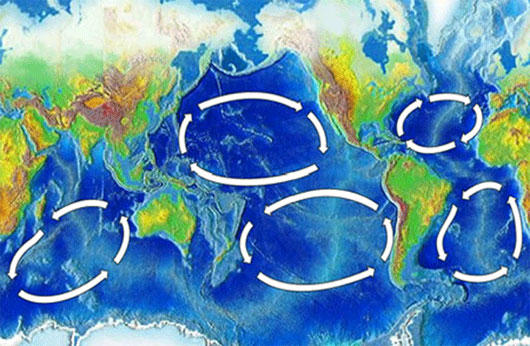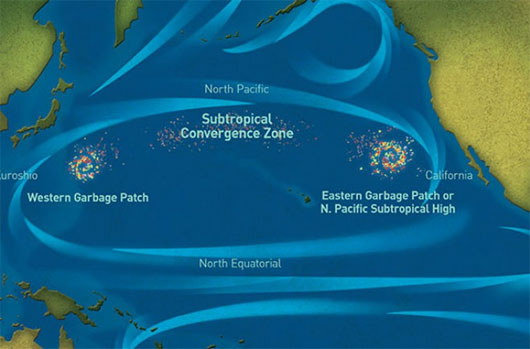The culprit makes it difficult to find aircraft MH370
Floating trash in the Indian Ocean circulation is making it difficult for Malaysia Airlines' efforts to track down missing MH370 aircraft, as search teams mistakenly identify them with aircraft fragments . So, what are ocean currents and why do they contain so much garbage?
Any circulating water flow or air flow can be considered a circulation line . However, this term is often used to refer to an ocean whirlpool .

Map of 5 major ocean circulation lines on Earth.(Photo: NOAA)
There are 5 major ocean circulation currents on Earth. In addition to the Indian Ocean circulation around Madagascar and Western Australia, our planet also has four other major circulation lines in the North and South Atlantic Ocean as well as in the North and South Pacific.
The ocean circulation flows formed by the wind, atmospheric pressure and rotation of the Earth. When the Earth rotates around its axis, a physical force is called the Coriolis effect, which causes the flow of currents to rotate in different directions, depending on their position. The North Atlantic and North Pacific currents rotate clockwise, while the Indian Ocean, South Atlantic and South Pacific circulation flows in the opposite direction.

Circulation flows keep large amounts of waste in circulation.(Photo: NOAA)
All 5 circulation lines confine large amounts of waste during circulation, because debris never wash ashore. Plastic flakes floating near the surface make up the bulk of this waste, along with larger objects such as foam blocks or fishing gear.
Garbage can be extremely dangerous, even fatal for sea creatures that swallow them randomly or by mistake as food. The flow of waste storage in the ocean is also where bacteria and chemical pollution are tolerated.
- New detection can help pinpoint the exact location of the MH370
- Hot: Detect exact location of aircraft MH370
- The cockpit of MH370 may have been ripped apart
- The real reason did not find MH370 for more than 3 years?
- MH370 has no driver when rushing into the sea
- Find a solution to the mystery of why MH370 left no fragments
- MH370 was intercepted by a fighter just before disappearing?
- Where is MH370 lost during the past 1 year?
- Australia found the missing area of MH370?
- How to not lose your flight like MH370
- Australian scientists are confident in determining the location MH370
- Australian scientist claims to know where MH370 falls
 'Fine laughs' - Scary and painful torture in ancient times
'Fine laughs' - Scary and painful torture in ancient times The sequence of numbers 142857 of the Egyptian pyramids is known as the strangest number in the world - Why?
The sequence of numbers 142857 of the Egyptian pyramids is known as the strangest number in the world - Why? History of the iron
History of the iron What is alum?
What is alum?